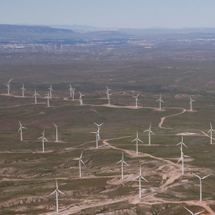 Duke Energy Renewables has confirmed that it is a subject of a U.S. Department of Justice (DOJ) preliminary investigation resulting from the incidental deaths of golden eagles and other migratory birds at two Wyoming company-owned wind farms.
Duke Energy Renewables has confirmed that it is a subject of a U.S. Department of Justice (DOJ) preliminary investigation resulting from the incidental deaths of golden eagles and other migratory birds at two Wyoming company-owned wind farms.
Duke Energy Renewables, which owns and operates four wind farms in Wyoming, says 10 golden eagle deaths have occurred at its 200 MW Top of the World wind farm since the wind farm began operating in October 2010. Duke also reported three golden eagle fatalities at its 99 MW Campbell Hill wind farm since December 2009.
Golden eagles receive federal protection under the Bald and Golden Eagle Protection Act (BGEPA). The law prohibits the taking of eagles, including killing, harassing, molesting or disturbing them or their nests. Concerns over civil and criminal liability under BGEPA have proven to be significant obstacles to the development of wind farms and have resulted in numerous stalled or canceled projects.
And as the company works with the DOJ and the U.S. Fish and Wildlife Service (FWS) toward a resolution, Tim Hayes, Duke Energy Renewables' environmental director, tells NAW that it has employed several adaptive management techniques to avoid additional avian impacts.
Adaptive management
Of the estimated 30,000 golden eagles in the U.S., nearly two-thirds reside in the western U.S. Given that, Hayes says the company has taken to removing objects and debris from its Wyoming sites, such as animal carcasses, to clear anything that birds and other avian species ‘may find attractive.’
The company also employs biologists to watch for birds at the sites. During the heavy migration season in winter and early spring, he says, Duke employs up to three biologists working at the Top of the World and Campbell Hill locations daily, to detect an eagle presence.
If eagles are spotted in the vicinity, he says, the biologists notify Duke's Charlotte, N.C.-based Renewable Energy Monitoring Center (REMC) to stop the turbines.
To test the effectiveness of curtailment, Hayes shut down 13 turbines during the first week of March where eagles were thought to be concentrated.
In the following weeks, he reinstated the informed curtailment program, where biologists in the field would call the REMC to shut down turbines only when eagles were spotted in the vicinity.
Duke went so far as to employ a radar surveillance system featuring the same technology used by the U.S. military to detect missiles in Afghanistan.
Beginning in Dec. 2012, Hayes says Duke began a six-month test of Syracuse, N.Y.-based SRC's avian surveillance radar system. He says the surveillance system helps to provide real-time situational awareness and early warning of potential strikes. According to Hayes, the test ends in June.
Thus far, Duke's adaptive management efforts have resulted in zero golden eagle fatalities at either wind farm since September 2012, Hayes reports.
Despite the challenges to protect the avian species, Hayes says Duke is in a much better position to understand – and therefore protect – avian species, such as golden eagles.
‘We know a whole lot more now than we did in the early 2000s, even five years ago,’ he says. ‘We're just starting to get an understanding of the issues. It's been a learning process for the entire industry.’
Photo caption: Duke Energy's Top of the World wind farm
Photo courtesy of Duke Energy Renewables



